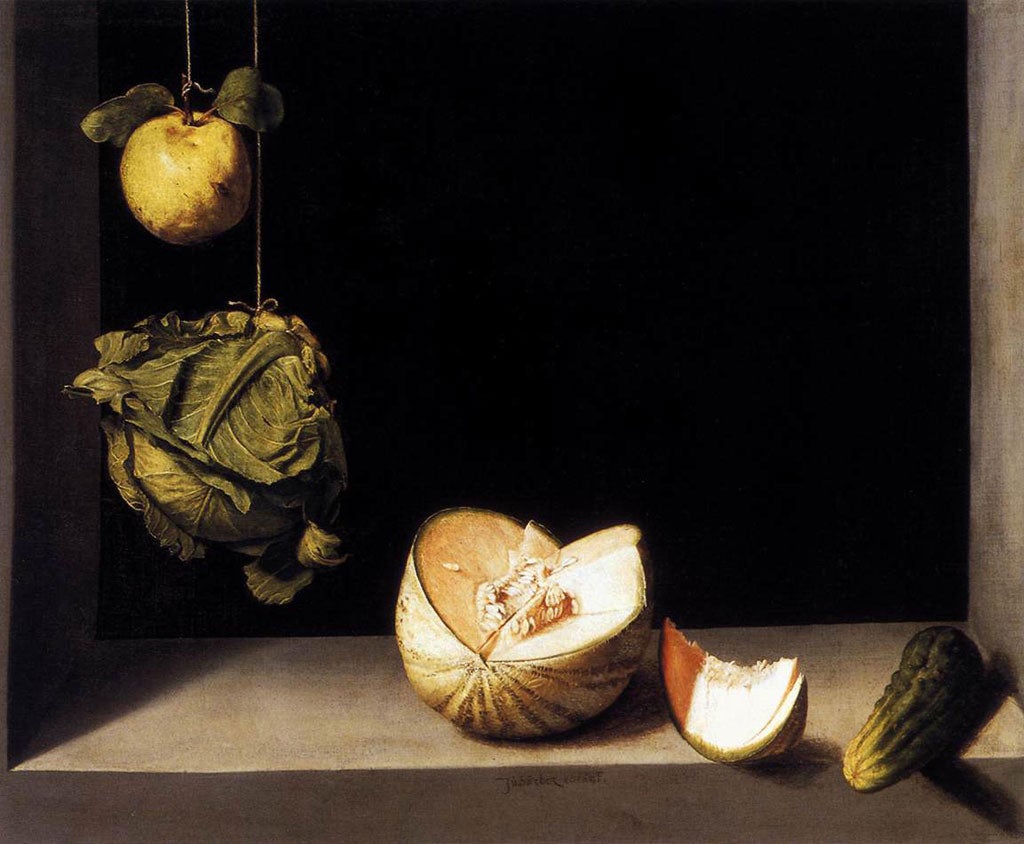Great Works: Still Life with Quince, Cabbage, Melon and Cucumber, c1602 (290 cm x 239 cm), Sanchez Cotan
San Diego Museum of Art

Your support helps us to tell the story
From reproductive rights to climate change to Big Tech, The Independent is on the ground when the story is developing. Whether it's investigating the financials of Elon Musk's pro-Trump PAC or producing our latest documentary, 'The A Word', which shines a light on the American women fighting for reproductive rights, we know how important it is to parse out the facts from the messaging.
At such a critical moment in US history, we need reporters on the ground. Your donation allows us to keep sending journalists to speak to both sides of the story.
The Independent is trusted by Americans across the entire political spectrum. And unlike many other quality news outlets, we choose not to lock Americans out of our reporting and analysis with paywalls. We believe quality journalism should be available to everyone, paid for by those who can afford it.
Your support makes all the difference.As living, sentient, ever inquisitive, ever watchful, ever needy human beings, we so often want the things of the world to be more than just themselves. We do not want objects to fall back into a bare thinginess. We want to see them as symbols, emblems, metaphors. We want them to remind us of states of mind or soul. And yet how can they do such a thing? Not without our generous interpretative help is the simple answer. A quince, a cabbage, a melon, a cucumber has no life of its own. It has no voice with which to utter its preferences for this, that or the other. It cannot complain when it is brutalised by the edge of a kitchen knife.
This extraordinary still life from the first decade of the 17th century in Spain, painted at a moment when Shakespeare had entered into his maturity as a playwright, seems to be so much more than the slightly meagre and austere sum of its parts. Unlike some of those Dutch still lifes I was referring to last week, this painting completely lacks the kind of decorative exuberance, the brash and brassy visual trumpeting, we so often associate with Dutch still lifes of flowers. In fact, if we were to name the constituent parts of this painting, our pulse would not necessarily race. Looking from high left to lower right, we see a suspended quince, a rather florid cabbage, a melon partially cut into, a slice from that same melon, and, overhanging the edge of the shelf as if peering into the void – and much of this painting consists of the kind of dark void which inclines us towards the contemplation of the metaphysical things of life – a cucumber.
Yes, here they all are, displayed one after another, as if in some kind of inscrutable logical or mathematical sequence, upon or above a very plain table top. We are not even especially pleased or visually stimulated by the sight of this table top. It could have been so much more, we feel. It could, for example, have been the surface of a well used refectory table, with the interesting markings that regular use would have guaranteed. There are no marks of the knife blade to give it any kind of a decorative quality. It is almost as if some of the potentially interesting qualities of this grey table top have been smoothed away into relative inconsequentiality in order to make what sits on it – or hangs mysteriously suspended above it – shine all the more brightly by comparison.
Although we are aware that to hang a fruit or a cabbage in this way helped to arrest its decay, we cannot but feel that there is more to it than this. The composition of these elements feels altogether more searchingly curious. Cotan himself was a Carthusian, and a profound religious sensibility is at work here in this painting, giving the simplest and the most unadorned fruits or vegetables, by their arrangement here, by their relative positioning, by the way they are being set apart and offered up to us, one by one, and each one seemingly suffused with a preternatural light from some undisclosed source, a kind of spiritual aura. The quince and the cabbage could be planets turning. Each element of this painting feels like a very singular gift, set apart from all the rest. They have been wrested, miraculously, from their humbleness.
Kitchens are usually sites of uproar. Not so this place. This place, in its strangely appealing stillness, could not be more turned away from the world. Creation itself is God's gift to us, the message seems to be. The smallest and the humblest part of it is precious, and deserving of close and reverential study. Our role is to reflect upon that fact and be thankful. Was not the Man of Sorrows himself suspended from Calvary's tree?
ABOUT THE ARTIST
Juan Sanchez Cotan (1560-1627) was active in Toledo as a painter of still lifes at the turn of the 17th century. His greatest paintings were spare, gloriously illusionistic arrangements of fruit and vegetables. His paintings wholly lack the mythological or historical resonance of Peter Paul Rubens. With a kind of monkish spareness, they offer up to the onlooker the precious, unadorned fruits of creation.
Join our commenting forum
Join thought-provoking conversations, follow other Independent readers and see their replies
Comments